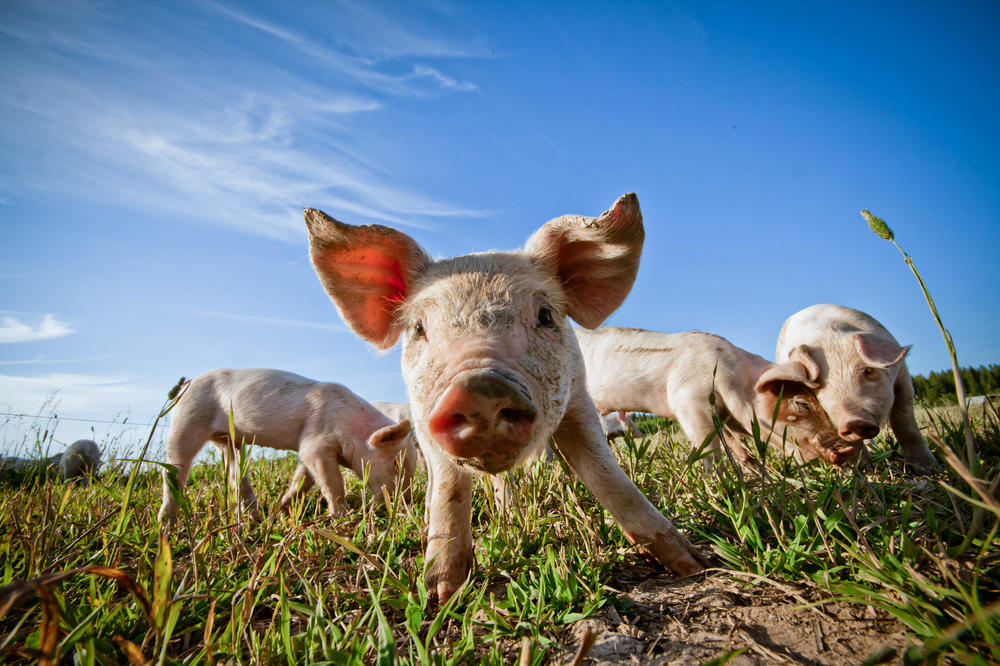Eating High on the Hog with Superfoods for Pigs
Rye is good for pigs and offers a whole host of advantages that even benefit the environment
Aug 14, 2020
Pigs are omnivorous animals. Scientists at Freie Universität are currently researching how best to feed them, especially in a way that is environmentally friendly.
Image Credit: shutterstock/talseN
Humans and pigs have quite a lot in common. Unlike cows, we each have just one stomach, and we are omnivores, meaning that we need to eat a wide variety of different food types in order to stay healthy. Grains and high-protein feed ensure that fattening pigs rapidly gain muscle mass. This is where mixed feed becomes crucial. It’s hoped that rye, a grain that tends to be forgotten when it comes to feeding livestock, will soon play a greater role in the future, especially in combination with rapeseed.
To this end, the German Federal Ministry of Food and Agriculture has put together an innovation program called the “Six R Concept.” Its name stands for “Regional Renaissance of Rye and Rapeseed to Reduce Problems in Plant Cultivation and Animal Production by Reevaluating Ingredients.” While promoting animal health is a significant goal of the initiative, driving forward sustainability and climate-friendly agricultural practices are also core components. In addition to Freie Universität Berlin, the University of Bonn, University of Veterinary Medicine Hannover, and seed producer KWS are further participants in this project.
Rye’s Image Problem
“Rye isn’t a recent addition to animal feed. But it has been much maligned over the years – and we think it’s time that changed,” says Professor Jürgen Zentek from the Institute of Animal Nutrition at Freie Universität Berlin. This aromatic, slightly bitter grain used to have something of an image problem. Its yields were low compared to wheat and it was susceptible to ergot fungus, which produces alkaloids that are highly toxic to both humans and animals. Improvements in cultivation processes have reduced these problems to a minimum. It is now possible to weed out Claviceps purpurea fungi, which are darker in color, using a sieve and color scanner.
This makes modern hybrid rye varieties true all-rounders that boast the benefits typically offered by other grains. Rye contains more fiber than wheat, flourishes even in low-nutrient, sandy soils, is more resilient against leaf diseases, and can survive at winter temperatures as low as –25 degrees Celsius. What’s more, its far-reaching roots allow it to thrive with significantly less nitrogen fertilizer and a third less of the water needed for wheat.
Rye Helps to Reduce Salmonella
Jürgen Zentek researches how hybrid rye impacts pigs’ health. Studies on rye-based feed mixtures have shown that it has very positive effects on the animal’s intestinal mucosa. “Rye contains more non-starch polysaccharides than wheat. Because these are not broken down as quickly, they end up in the pig’s hindgut. Here, they are fermented by microorganisms that produce substances like butyric acid. This nourishes the intestinal mucosa and can have positive effects on how inflammatory processes are regulated,” explains Zentek.
Veterinarians at the University of Veterinary Medicine Hannover have also determined that less salmonella can be found in the intestines of pigs fed on rye. Healthier pigs need fewer antibiotics, which is good for both human and pig health as well as the environment. All this makes rye a bona fide superfood that also benefits the human digestive tract. A further plus of this versatile grain is that it doesn’t need to be transported far because it is also grown in our region. Rye is a crop that is traditionally cultivated in Eastern Germany, particularly in Brandenburg.
Soy – Another Nutritious Feed Additive
Wheat and soy meal from South and North America is frequently added to pig feed. Cultivation of new varieties has now allowed soy to thrive in colder regions, from the Balkans all the way to Ukraine. “It’s one of our flagship policies to replace soy meal because we already have good indigenous sources of protein. Rapeseed meal – a high-protein by-product of rapeseed oil production – is a valuable source of protein that is important for animal nutrition and can also easily be combined with rye,” says Zentek. However, other ongoing research projects are also concerned with achieving greater sustainability in bread, meat, milk, and egg production.
The same varieties of grains are used for bread and animal feed. The only difference between them lies in quality, which is determined by growth and harvest conditions. The grain size primarily determines whether rye will be used in bread or in feed. “Smaller grains contain less starch, which means they are less suitable for use in bakeries. On the other hand, they contain more protein and fiber, which makes them perfect for animal feed,” says Zentek. By-products like rye bran will also be put into greater use.
If all 18,000 pig farms in Germany with about 17 million animals switched to rye-based feed, this alone would reduce the carbon emissions produced by agriculture each year by 20 percent – this works out at a whopping 6.5 tons. Rye is also more robust when faced with dry spells, which means that it is better equipped for climate change than wheat. These are all great reasons to support rye’s renaissance in animal feed production. Just one question remains: what do the pigs make of all of this? Well, it seems they enjoy eating both!
This text originally appeared in German on June 21, 2020, in the Tagesspiegel newspaper supplement published by Freie Universität.
Further Information
Professor Jürgen Zentek, Institute of Animal Nutrition, Department of Veterinary Medicine, Freie Universität Berlin, Email: zentek.juergen@vetmed.fu-berlin.de

